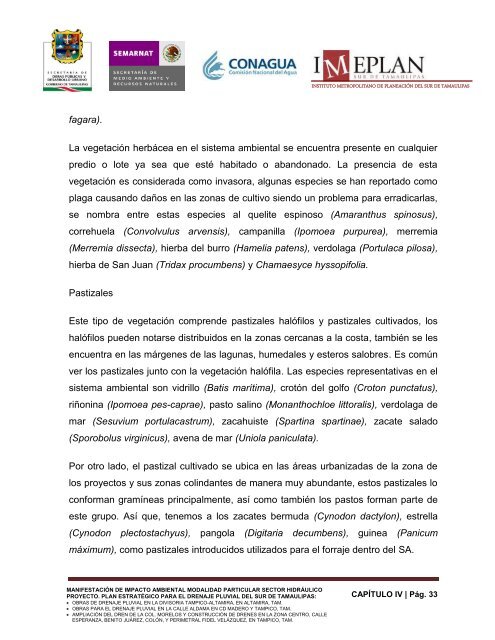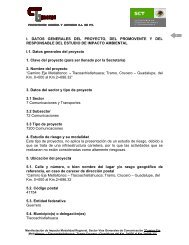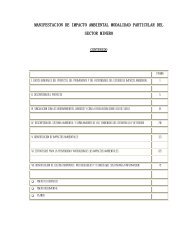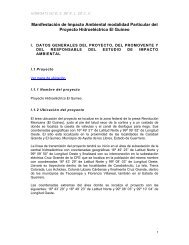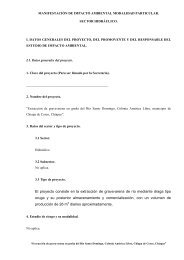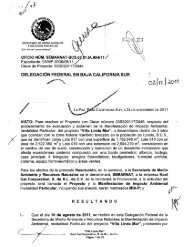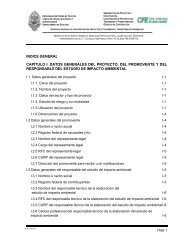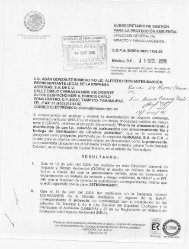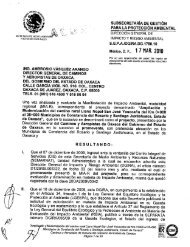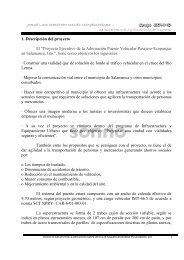plan estratégico para el drenaje pluvial del sur de ... - sinat - Semarnat
plan estratégico para el drenaje pluvial del sur de ... - sinat - Semarnat
plan estratégico para el drenaje pluvial del sur de ... - sinat - Semarnat
You also want an ePaper? Increase the reach of your titles
YUMPU automatically turns print PDFs into web optimized ePapers that Google loves.
fagara).<br />
MANIFESTACIÓN DE IMPACTO AMBIENTAL MODALIDAD PARTICULAR SECTOR HIDRÁULICO<br />
PROYECTO. PLAN ESTRATÉGICO PARA EL DRENAJE PLUVIAL DEL SUR DE TAMAULIPAS:<br />
OBRAS DE DRENAJE PLUVIAL EN LA DIVISORIA TAMPICO-ALTAMIRA, EN ALTAMIRA, TAM.<br />
OBRAS PARA EL DRENAJE PLUVIAL EN LA CALLE ALDAMA EN CD MADERO Y TAMPICO, TAM.<br />
AMPLIACIÓN DEL DREN DE LA COL. MORELOS Y CONSTRUCCIÓN DE DRENES EN LA ZONA CENTRO, CALLE<br />
ESPERANZA, BENITO JUÁREZ, COLÓN, Y PERIMETRAL FIDEL VELÁZQUEZ, EN TAMPICO, TAM.<br />
INSTITUTO METROPOLITANO DE PLANEACIÓN DEL SUR DE TAMAULIPAS<br />
La vegetación herbácea en <strong>el</strong> sistema ambiental se encuentra presente en cualquier<br />
predio o lote ya sea que esté habitado o abandonado. La presencia <strong>de</strong> esta<br />
vegetación es consi<strong>de</strong>rada como invasora, algunas especies se han reportado como<br />
plaga causando daños en las zonas <strong>de</strong> cultivo siendo un problema <strong>para</strong> erradicarlas,<br />
se nombra entre estas especies al qu<strong>el</strong>ite espinoso (Amaranthus spinosus),<br />
correhu<strong>el</strong>a (Convolvulus arvensis), campanilla (Ipomoea purpurea), merremia<br />
(Merremia dissecta), hierba d<strong>el</strong> burro (Ham<strong>el</strong>ia patens), verdolaga (Portulaca pilosa),<br />
hierba <strong>de</strong> San Juan (Tridax procumbens) y Chamaesyce hyssopifolia.<br />
Pastizales<br />
Este tipo <strong>de</strong> vegetación compren<strong>de</strong> pastizales halófilos y pastizales cultivados, los<br />
halófilos pue<strong>de</strong>n notarse distribuidos en la zonas cercanas a la costa, también se les<br />
encuentra en las márgenes <strong>de</strong> las lagunas, humedales y esteros salobres. Es común<br />
ver los pastizales junto con la vegetación halófila. Las especies representativas en <strong>el</strong><br />
sistema ambiental son vidrillo (Batis marítima), crotón d<strong>el</strong> golfo (Croton punctatus),<br />
riñonina (Ipomoea pes-caprae), pasto salino (Monanthochloe littoralis), verdolaga <strong>de</strong><br />
mar (Sesuvium portulacastrum), zacahuiste (Spartina spartinae), zacate salado<br />
(Sporobolus virginicus), avena <strong>de</strong> mar (Uniola paniculata).<br />
Por otro lado, <strong>el</strong> pastizal cultivado se ubica en las áreas urbanizadas <strong>de</strong> la zona <strong>de</strong><br />
los proyectos y sus zonas colindantes <strong>de</strong> manera muy abundante, estos pastizales lo<br />
conforman gramíneas principalmente, así como también los pastos forman parte <strong>de</strong><br />
este grupo. Así que, tenemos a los zacates bermuda (Cynodon dactylon), estr<strong>el</strong>la<br />
(Cynodon plectostachyus), pangola (Digitaria <strong>de</strong>cumbens), guinea (Panicum<br />
máximum), como pastizales introducidos utilizados <strong>para</strong> <strong>el</strong> forraje <strong>de</strong>ntro d<strong>el</strong> SA.<br />
CAPÍTULO IV | Pág. 33


